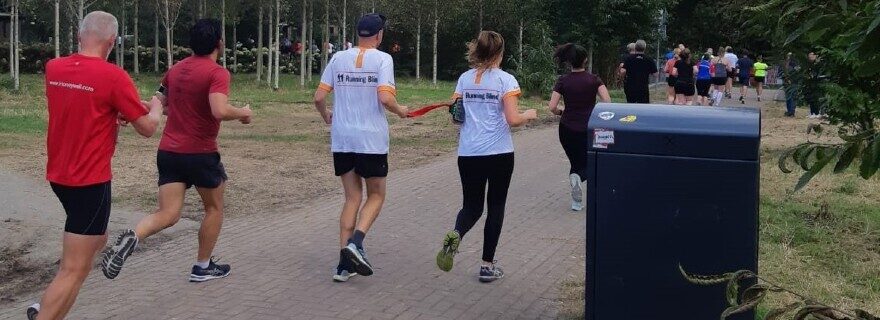Understanding blind running through participant sensation
The organization Running Blind matches people with visual impairments to a sighted runner. They run while both holding the ends of a tether. Marit Hiemstra explains how being a guide, and applying the method of ‘participant sensation’ enabled her to study the embodied role of trust in blind running.
Sensory research
As a congenital seer, I take visual perceptions for granted. Seeing shapes most of my activities. When I run, I see where surfaces change; I see cyclists and other runners passing by and I see the path I am running on. Based on these visual perceptions, I move through that environment. People with visual impairments perceive the world through other senses, like touch, sound, smell and taste. During runs, runners with visual impairments sense the changing surfaces through the touch of their feet; they hear cyclists and other runners passing by and they stay on the path by following verbal directions of the guide runner or the guidance of the tether. The differences in the ways we move through, or run through, our environments show how our knowledge of our surroundings is always embodied.
When I started to study blind running, I immediately became aware of the visual-centrism of my experiences of the world. As the blind runners I worked with perceived the world quite differently, I wondered: Might it be possible to gain an understanding of how others perceive the world by attending to our own sense-making processes? I learned that studying people with a sensory impairment demands a rethinking of the conventional anthropological method of participant observation. Implicitly assuming that the world of others can be understood through participation and observation, the method leaves little space for other sensations of the world. Therefore, David Howes (2019), among other anthropologists, emphasizes the importance of ‘participant sensation’, a method to understand the social world about and through sensing, sense-making and participating in sensations along with others. Adopting this method, I made sensing and the senses both an object of study and means of inquiry in my ethnographic research.
Blind trust
Practicing blind running means being connected throughout the run. The runners hold a fluorescent, cotton tether in between their bodies. When I first met my running buddy, he introduced me to this tether, as I wrote in my field notes:
‘So, Marit, this is a Running Blind tether. Because I prefer to run on your left side, you hold it in your left hand between your thumb and index finger, or your index finger and middle finger, whatever feels most comfortable for you. I hold the other side of the tether. When we run, the tether is always between us. You have to make sure you move your arm because otherwise it might be cramping up. More importantly, you can guide me by moving your arm. By pulling the tether gently, you can pull me in a certain direction. By pulling it firmly, you warn me and you make us stop.’ I hold the tether and I start to feel a little distressed. ‘What if I let you trip?’ He laughs. ‘If I bump into a tree, I’ll say: Marit, that’s super silly, but if I stumble, no worries! You also stumble or slip sometimes. Things like that happen.’
This first encounter instantly evoked the importance of trust in blind running. When running tethered, visually impaired runners have to trust their buddy’s skills. Guide runners similarly learn to trust their own skills in translating the elements of the environment properly. Building trust through recurrent practice, the runners start to jointly attune to the running environment. As many of my interviewees told me, and as I came to experience myself, once a duo has mutual confidence and trust in the running practice, the running bodies evolve from two separate running beings into one holistic running being. Even though the runners perceive the environment through different senses, their tethered bodies shape the sensations of the environment into one understanding and make them one sense-making being. A Running Blind experience is thus more than the sum of its parts since both runners actively contribute to the creation of a new, joint understanding.
Shared understandings
Sensing along with my research interlocutors attuned me to the importance of the mutual experience of trust in blind running. For me, examining my own feelings of trust while becoming a guide runner and the other runners’ feelings of trust opened up a space to delve into blind running sensations. Through this process I started to understand how running bodies gradually attune to the world and eventually create joint running experiences. Partage du sensible (Laplantine 2015), sharing the sensible, that is the value of participant sensation in anthropological research.
This blog is based on Marit Hiemstra’s master thesis: “Get Tethered- Blind Running as a Lived Experience of Sports Inclusion”. The thesis comes with a podcast (Dutch) in which Marit together with her running buddy Martijn discuss their Running Blind experiences.



0 Comments
Add a comment